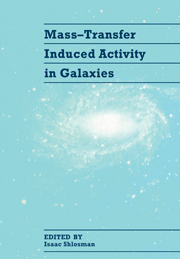Book contents
- Frontmatter
- Contents
- Preface
- List of Participants
- I INTRODUCTION
- II THE INNER PARSEC
- III THE CIRCUMNUCLEAR REGION
- IV GAS DYNAMICS AND STAR FORMATION IN BARRED AND NORMAL GALAXIES
- V NUCLEAR GAS AND LARGE-SCALE PROPERTIES OF AGN AND STARBURST HOSTS
- HI and H2 in Luminous Interacting Galaxies (Invited paper)
- HIFI Results on the Superbubble of NGC 3079
- Low Surface Brightness Galaxies: Evolution without Mass Transfer
- Bulge Formation by Starbursts in Young Galaxies
- CO Observations of Nearby Active Galaxies
- Starburst Evolution on the IRAS–Color Diagram
- Cloud Collisions and Bulge Formation in Disk Galaxies 23
- VI HOST GALAXY-AGN-NUCLEAR STARBURST CONNECTION
- VII GALAXY INTERACTIONS AND INDUCED ACTIVITY
- VIII GAS DYNAMICS IN ELLIPTICALS
- IX AGN AND STARBURST HOSTS AT LARGE REDSHIFTS
- X CONFERENCE SUMMARY
- Subject Index
- Object Index
- Author Index
Starburst Evolution on the IRAS–Color Diagram
Published online by Cambridge University Press: 05 May 2010
- Frontmatter
- Contents
- Preface
- List of Participants
- I INTRODUCTION
- II THE INNER PARSEC
- III THE CIRCUMNUCLEAR REGION
- IV GAS DYNAMICS AND STAR FORMATION IN BARRED AND NORMAL GALAXIES
- V NUCLEAR GAS AND LARGE-SCALE PROPERTIES OF AGN AND STARBURST HOSTS
- HI and H2 in Luminous Interacting Galaxies (Invited paper)
- HIFI Results on the Superbubble of NGC 3079
- Low Surface Brightness Galaxies: Evolution without Mass Transfer
- Bulge Formation by Starbursts in Young Galaxies
- CO Observations of Nearby Active Galaxies
- Starburst Evolution on the IRAS–Color Diagram
- Cloud Collisions and Bulge Formation in Disk Galaxies 23
- VI HOST GALAXY-AGN-NUCLEAR STARBURST CONNECTION
- VII GALAXY INTERACTIONS AND INDUCED ACTIVITY
- VIII GAS DYNAMICS IN ELLIPTICALS
- IX AGN AND STARBURST HOSTS AT LARGE REDSHIFTS
- X CONFERENCE SUMMARY
- Subject Index
- Object Index
- Author Index
Summary
ABSTRACT
In order to study effects of the starburst activity on far-infrared (FIR) colors, we have constructed starburst models which are able to trace FIR color evolution of starburst activity.
INTRODUCTION
The IRAS mission discovered that FIR emission properties of galaxies are significantly altered by starburst activity. Therefore, the FIR properties of galaxies are used to study the nature of starburst activity, in principle. Since, however, it is difficult to know properties of dust grains unambiguously, little effort has been made to construct starburst models which are able to reproduce FIR properties of galaxies (cf. Rowan-Robinson 1992). We here present a simple starburst model capable for calculating FIR emission of starburst galaxies.
MODEL AND RESULTS
The infrared continuum emission comes from dust grains embedded in ionized gas and from those in molecular clouds. The large grains are in thermal equilibrium with the radiation field and radiate as a blackbody with an emissivity Qλ ∝ λ-1. On the other hand, small grains are heated transiently by single UV photons. In our model, emission at 12 and 25 μm mainly comes from small grains in the molecular clouds and large grains in the ionized gas, while emission at 60 and 100 μm comes from large grains in the molecular clouds. The basic concept of our model was given in Mouri and Taniguchi (1992). Our new model is now able to calculate FIR emission from 12 to 100 μm directly and to trace the full phase of starburst evolution. Detailed description will be given elsewhere.
- Type
- Chapter
- Information
- Mass-Transfer Induced Activity in Galaxies , pp. 230 - 231Publisher: Cambridge University PressPrint publication year: 1994

